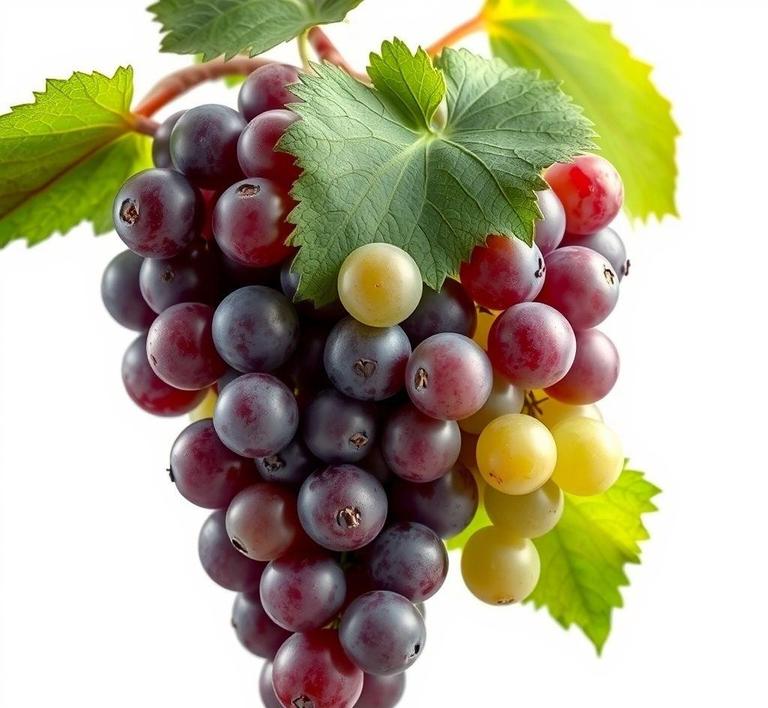If you’re looking to enjoy a refreshing, sweet treat that’s both healthy and easy to prepare, refreezing grapes is a fantastic option. These little bursts of flavor become extra juicy and icy when frozen, making them perfect for snacking, adding to drinks, or even using as an ice cube alternative in your beverages. Plus, freezing grapes helps extend their shelf life, so you can store them for longer without worrying about them going bad. Whether you’re cooling off on a hot day or just want a snack that feels a little more indulgent, refreezing grapes is simple and absolutely delicious!
Can You Refreeze Grapes?

Refreezing grapes is a question that often pops up, especially for those who love keeping their fruits in the freezer for later use. The short answer is yes, you can refreeze grapes, but it’s not always a straightforward process. To understand why, we need to explore the nature of grapes and the freezing process itself.
When grapes are frozen, the water inside them expands as it freezes, causing the cell walls to rupture. This is why frozen grapes have a different texture once thawed, becoming softer and juicier. This natural phenomenon occurs with most fruits, as the freezing process changes their structure.
However, when you thaw grapes and then freeze them again, this cycle of freezing and thawing can lead to a greater loss of texture. This happens because the initial freezing breaks down the cellular structure, and refreezing doesn’t give the grapes a chance to recover. As a result, the fruit can become mushier and less appealing.
That being said, refreezing grapes is totally possible, especially if you’re not too concerned with maintaining their perfect texture. The key consideration should be what you’re using them for once refrozen. For example, refrozen grapes might be fine for smoothies or as a chilled addition to a punch, but they won’t hold up well in dishes where texture plays a major role, like in a salad.
How To Refreeze Grapes?
If you decide that refreezing grapes is the right move for you, it’s important to follow a method that minimizes quality loss. Here’s a step-by-step guide on how to do it properly:
1. Thawing The Grapes Properly
If your grapes are already frozen, you’ll need to start by thawing them before refreezing. However, it’s important to do this gently. The best way to thaw grapes is by transferring them from the freezer to the fridge and letting them thaw overnight. This slow thawing method helps retain some of the grapes’ structure. Avoid thawing them on the counter at room temperature because this can cause them to become too soft and mushy before they are refrozen.
2. Inspecting The Grapes
Once thawed, check the grapes for any signs of spoilage. Grapes are perishable, and after thawing, they’re more susceptible to deteriorating quickly. If any of the grapes are soft, mushy, or have developed an off smell, it’s best to discard them. Use only the firm and fresh ones for refreezing.
3. Flash-Freezing The Grapes (Optional But Recommended)
To preserve as much texture as possible, flash-freezing your grapes before placing them in a container or bag is highly recommended. This process helps keep each grape separate, preventing them from clumping together in a big frozen mass. Here’s how:
- Lay the grapes out in a single layer on a baking sheet or tray.
- Make sure the grapes are not touching each other to prevent sticking.
- Place the tray in the freezer for 2-3 hours or until the grapes are fully frozen.
Flash-freezing helps maintain their shape and texture for the most part, especially if you plan on using them for snacking or smoothies later on.
4. Storing The Grapes
After flash-freezing, transfer the grapes into a freezer-safe bag or airtight container. If using a bag, be sure to remove as much air as possible to avoid freezer burn. You can use a vacuum sealer for an airtight seal, which is especially helpful for long-term storage. Label the bag with the date, so you remember when they were refrozen.
Quality Impact
When refreezing grapes, quality is the main factor to consider. The process of freezing and thawing alters the texture and taste of the fruit, and each cycle compounds these changes. Here are the major impacts on quality:
Texture
The biggest change in refrozen grapes is their texture. Grapes, like most fruits, have a high water content, and when frozen, the water inside them expands and ruptures the cell walls. This is why they turn soft and squishy after thawing. When refrozen, the breakdown is more severe, resulting in a mushier texture. For those who like to snack on frozen grapes, this could be a dealbreaker, as they won’t have the same firm, refreshing bite they had the first time around.
However, if you’re using them for a smoothie or as part of a frozen dessert, the texture loss isn’t as important. The fruit will blend well, and the slight mushiness won’t detract from the final product.
Flavor
While the flavor of grapes doesn’t change drastically with freezing and thawing, the impact of refreezing could cause a slight dulling of taste. Freezing grapes too long can lead to freezer burn, which results in off-flavors or a less sweet taste. If the grapes are properly stored and not frozen for an extended period, the flavor should be relatively intact, though it may not be as vibrant as freshly frozen ones.
Nutrient Loss
There is a small loss of nutrients each time fruit is thawed and refrozen, though it is generally negligible. Freezing causes a slight degradation of certain vitamins, particularly vitamin C, but the losses are minimal. Refreezing doesn’t necessarily double the loss, but it can lead to a marginal decrease in nutrient quality over time. If your goal is to preserve as much nutritional value as possible, you may want to consider using the grapes sooner rather than later.
Refreezing grapes is entirely feasible, but the process does come with a few caveats. While it’s not going to ruin the grapes or make them unsafe to eat, the textural changes are significant. Once thawed, grapes become softer and more fragile, and refreezing them exacerbates this effect. They’re no longer crisp or firm, but this doesn’t necessarily mean they’re bad-they just may not be suitable for all purposes.
If you’re planning to use refrozen grapes for smoothies, cocktails, or as a snack that’s meant to be blended or consumed in their frozen form, the quality impact will be minimal. However, if you’re expecting them to retain their original fresh state for salads or fresh dishes, the difference will be more noticeable.
In short, while refreezing grapes won’t harm you, it will change their texture, making them better suited for applications where their softer, juicier consistency won’t be a drawback. For optimal taste and texture, it’s best to use frozen grapes within a reasonable timeframe after the first freeze and limit the number of times they’re thawed and refrozen.
Is It Safe To Refreeze Grapes?
Refreezing grapes is a practice that can be done safely, but it comes with caveats. Grapes, like many other fruits, are predominantly water, making them highly susceptible to changes in texture and taste when frozen and thawed repeatedly. The process of freezing causes water inside the cells to expand, which can rupture cell walls. This is why fresh grapes, once frozen and thawed, may become mushy or soft. However, as long as they are handled properly, it is possible to refreeze grapes without significantly compromising their safety.
From a food safety perspective, the main concern when refreezing grapes is bacterial growth. The key is to avoid leaving them at room temperature for extended periods before refreezing. If grapes have been thawed in the refrigerator and kept at a safe temperature (below 40°F or 4°C), then they can be safely refrozen. However, if grapes have been thawed at room temperature for more than two hours, they should not be refrozen due to the risk of bacterial contamination.
Additionally, refreezing grapes that have been exposed to improper handling-such as thawing multiple times or being stored in conditions that allowed them to thaw and refreeze several times-can lead to a decline in quality. The risk is higher when grapes have been thawed and refrozen without being stored correctly, leading to potential health risks.
Signs That Grapes Should Not Be Refrozen
Not all grapes are suitable for refreezing, and there are a few key signs that should prompt you to discard the fruit rather than try to preserve it for a second freeze:
- Softness and Mushiness: If the grapes have become overly soft or mushy after thawing, it’s a sign that the freezing process has compromised the texture beyond recovery. Refreezing them would only worsen the mushy texture, making them unappealing.
- Discoloration: Grapes that have turned brown or have developed dark spots should be avoided. This is often a sign that the grapes have begun to degrade or have been exposed to air for too long. Refreezing grapes with these signs can make them less appetizing and more prone to spoiling.
- Off Smell or Sour Odor: If thawed grapes emit an unpleasant or sour odor, it could indicate that they have begun to spoil. In this case, refreezing will only lock in the degradation and could increase the potential for foodborne illnesses.
- Excessive Ice Crystals: Grapes that have developed large ice crystals upon thawing can indicate that they have been stored improperly during the initial freezing process. This can negatively impact the texture, making them unsuitable for refreezing. Grapes should ideally be frozen quickly to minimize ice crystal formation.
- Bacterial Contamination: If grapes have been thawed at room temperature for a prolonged period or have shown any signs of mold, they should not be refrozen. Moldy or spoiled fruit poses a health risk and should be discarded immediately.
Common Refreezing Mistakes
When it comes to refreezing grapes, there are several common mistakes people make that can result in poor quality or even food safety concerns:
- Thawing at Room Temperature: One of the most common mistakes is thawing grapes at room temperature for too long. The USDA advises that perishable foods should not be left out for more than two hours. Leaving grapes out for too long can promote the growth of harmful bacteria, which makes refreezing unsafe.
- Refreezing Without Proper Packaging: If grapes are not stored in an airtight container or freezer bag, they can become exposed to air. This results in freezer burn, which occurs when moisture evaporates from the surface of the grapes. Refrozen grapes with freezer burn will lose flavor, texture, and overall quality.
- Multiple Thawing and Refreezing Cycles: Constantly thawing and refreezing grapes is a surefire way to degrade their texture and flavor. Each freeze-thaw cycle breaks down the structure of the fruit, resulting in a mushy and less enjoyable final product. Avoid thawing grapes unless you plan to consume them immediately or use them in recipes that mask texture, like smoothies or baked goods.
- Not Using Them Quickly Enough: Grapes that have been thawed should ideally be used within a few days. Waiting too long to refreeze them (after they’ve been thawed in the fridge) can lead to bacterial growth and quality loss, making the fruit unsafe and unpleasant to eat after refreezing.
- Overcrowding in the Freezer: If grapes are placed in the freezer too closely together, they can freeze in a lump. This reduces their ability to freeze evenly and can cause them to stick together in a frozen clump. For easier refreezing, it’s better to lay grapes out on a baking sheet or tray in a single layer, freeze them solid, and then transfer them to a bag or container.
Tips And Tricks
While there are challenges to refreezing grapes, there are several tips and tricks you can follow to ensure the best results:
- Flash Freeze Before Storing: Before storing grapes in a container or bag, spread them out in a single layer on a baking sheet and place them in the freezer for about two hours. This process, known as flash freezing, will prevent the grapes from sticking together in a clump. Once they’re frozen individually, transfer them to a sealed container or freezer bag for longer storage.
- Use Proper Storage Containers: Invest in high-quality, airtight containers or freezer bags specifically designed for freezing. The better the seal, the less likely the grapes will suffer from freezer burn or lose moisture.
- Choose Firm Grapes: When you initially freeze grapes, select the firmest and freshest ones available. Grapes that are already soft or near the end of their shelf life will not freeze well and will become mushy once thawed. Always pick grapes that are ripe but not overripe.
- Thaw in the Refrigerator: If you need to thaw frozen grapes, place them in the refrigerator rather than at room temperature. This keeps the fruit at a safe temperature and prevents bacterial growth. It also helps maintain the texture better than thawing them on the counter.
- Freeze in Small Batches: To avoid the hassle of thawing and refreezing large amounts of grapes, freeze them in smaller batches. This way, you can take out just what you need without needing to re-freeze portions repeatedly.
- Repurpose Thawed Grapes: Thawed grapes may not have the same crispness as fresh grapes, but they can still be used in other ways. Consider adding them to smoothies, yogurt, baked goods, or even making homemade jams or sauces. Thawed grapes work particularly well in recipes where texture is less of a concern.
- Label and Date Your Grapes: It’s easy to forget when you froze your grapes. Always label your storage bags or containers with the date, so you can keep track of how long they’ve been in the freezer. This will help you avoid keeping them frozen too long and will allow you to use the oldest batches first.
Conclusion
In conclusion, refreezing grapes is a viable option, but it requires proper handling to maintain safety and quality. While it’s generally safe to refreeze grapes that have been thawed correctly (i.e., kept in the refrigerator and within safe time limits), there are clear signs to watch for that indicate grapes should not be refrozen. Avoid common mistakes, such as thawing at room temperature or neglecting proper storage, and you’ll have a much better chance of keeping your grapes tasting fresh.
By following a few simple tips-such as flash freezing, using airtight containers, and thawing carefully-refrozen grapes can still be a delicious and safe snack or ingredient for smoothies and other dishes. However, it’s important to remember that while refreezing is possible, repeated cycles of freezing and thawing will always degrade the texture of the fruit. As long as you’re mindful of these details, you can safely enjoy your frozen grapes, even after they’ve been refrozen.


